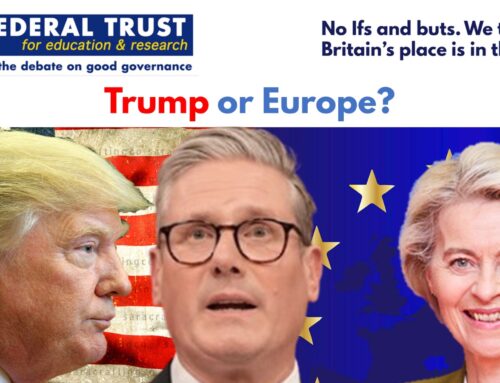 by Professor Sam Whimster
by Professor Sam Whimster
Deputy Director & Head of UK Futures Programme, Global Policy Institute
Have I seen this musical before? No, that is not a Hamilton moment, but the musical is based on Ron Chernow’s excellent biography of one of America’s founding fathers, Alexander Hamilton.
We used the term several times in our Federal Central Banks. A Comparison of the US Federal Reserve and the European Central Bank (2018).
“Europe lacked its own Hamiltonian founding moment and proceeded step by step on a monetary led strategy in place of an overall design that could resist the political contingencies, which came to determine policy” (p. 28). The argument here is that the establishment of the European Central Bank and the Euro was a long drawn out, and very hesitant process. In contrast we wrote: “Central banks in the US are a lesson in change. Alexander Hamilton’s Bank of the United States (1791) monetized the debts of the individual states through issuing new scrip and assured the credit worthiness of US debt, it established and minted a national currency, and it supported the expansion of manufacturing. The Bank of United States was an exercise in state-building, charged by George Washington and James Madison to bind together the individual states and charged by Congress to support the economy” (pp. 5-6).
Coming out of the American War of Independence the fledgling United States had to get its act together fast. The individual states had large debts and the debt varied greatly in both quantity and quality in different states. Arguments about sharing the debt at federal level were highly acrimonious. Then there was America’s foreign debt to countries like France. Infrastructure had to be built and the economy stabilized and then boosted. Hamilton followed the model of England and the Bank of England Charter which founded its central bank on the basis of an IPO whose successful subscription gave it financial capital and the ability to lend (mainly to the government to resolve war debt) at profitable rates of interest. Hamilton hoovered up as much debt as he could in order to establish a currency and transform bad debt into sound government Treasuries.
Europe did not have its foundational moment at a time of crisis. In the 1960s it had the irritation of floating exchange rates, post Bretton Woods disorder, and the volatilities caused by speculative Eurodollars. It inched its way through the Exchange Rate Mechanism toward establishing what was then thought of as an optimal currency zone. In the recent Federal Constitutional Court of Germany ruling, some of the Complaints used the term Währungspolitik, currency policy. This is inaccurate. Even it its foundation the European System of Central Banks (whose Council governs the European Central Bank) was mandated to operate monetary policy. A central authority, some sort of state, has to run a monetary policy. Whereas a common currency area simply allows a number of states voluntarily to share a currency. Hamilton drove the argument in Congress that America should have all the powers and capacity of a modern state and these included a Treasury and a national currency. It was political from the start.
Our book points out that early architects of the Euro, like John Pinder, foresaw the political problems. In a monetary zone with the free movement of capital and people regional imbalances would occur, not just northern and southern Italy but a divide between the northern powerhouse economies and the Mediterranean economies – a variant of the Pirenne thesis. So ideas were formulated about the necessity of an European Monetary Fund which would equalize strains between regions and member countries. Hamilton’s best federal designs were undone by Presidents Jefferson and Jackson, respectively, though 140 years later under President F.D. Roosevelt and Marriner Eccles at the Federal Reserve and Treasury Secretary, Henry Morgenthau, the United States was finally equipped with a depression beating fiscal-monetary institution – and a world-beating international currency.
“The stand-out difference,” to quote from our book, “for Europe is that the European Union is not a federal state. It has many Presidents – of the Parliament, of the Commission, of the Council, of the ECB, of the Eurogroup – but there is no presidential executive leadership. This is simply the difference between a federal and a confederal political system. The other stand-out difference – amazingly usually overlooked – is that the EU and EZ do not have a Treasury. To create, so to speak, the float on which the ECB was launched, national central banks committed a large portion of their reserves to the ECB. Taken with Maastricht criteria, this represented a critical loss of monetary sovereignty by nation states to the new currency and the ECB, without however the ECB achieving an increase in its monetary sovereignty commensurate with the loss experienced at national level. In a financial crisis Treasury and central bank have to work hand in hand, with Treasuries (or Finance Departments) doing the heavy lifting of issuing bonds and altering taxation to cover the chasms of bankrupt banks and deficit state budgets. As already noted this was in the first blueprint of Horst Schulman in the form of the EMF, but the ECB in its compromised design was not given this capacity” (pp. 38-9).
Missing the moment
When it came to the great financial crisis starting in 2008, “Brussels missed the ‘Hamiltonian moment’ presented by the crisis to instigate genuine federal solutions. Simeon Djankov, the finance minister of Bulgaria had an insider’s seat, as a member of Ecofin, from 2009 to 2014. At the Commission, Djankov notes, President Barroso did nothing, and Juncker as head of the Ecofin group repeated the mantra of Delors, Kohl et al that a federal solution would be found. Djankov explains that this was not forthcoming because Commissioners were nominated by national governments and it was happenstance whether a Commissioner with financial experience was nominated. “This lack of initiative [from Brussels] had developed historically from overdependence on the largest member states, mostly Germany. […] Neither President Barroso nor President Herman Van Rompuy nor Commissioner Rehn were empowered to propose a plan” (Inside the Euro Crisis, p. 51).
Where is Alexander Hamilton when you need him? History puts on an epic production to be followed by a musical. Instead we got swarms of economists, still resolute that monetary policy alone can cure a general economic breakdown. Draghi did what it took, but asserting all the time that fiscal policy needs to play its part too. This was ignored. The UK’s intellectual contribution was “Osbornomics” and the evil political formulation to demonize ‘shirkers’ as undeserving of aid while bankers had to be kept in business. “Oh to be reborn as a bond dealer” – to reprise Bill Clinton. Students of economic theory will recognize the figure of the shirker in Joseph Stiglitz’s depiction of the labor market. There is continuity, and the lesson is that politicians should be wary of economists laden with theories.
The Hamiltonian moment is with us again, now voiced by Olaf Scholz. This is pretty amazing since Scholz as Germany’s finance minister had doubled down on his predecessor’s (Wolfgang Schäuble) delight in budget surpluses. Interviewed by Die Zeit (23 May 2020) Scholz argued for fiscal reforms offering the historical role model: “Der erste US-Finanzminister Alexander Hamilton bündelte im Jahr 1790 auf Ebene des Zentralstaats die Kompetenzen, gemeinsame Einnahmen zu erzielen, und eine eigenständige Verschuldungsfähigkeit”. So, Scholz recommends bundling together a central state competence, a common fiscal income, and an independent capacity to issue debt. That’s not quite the full Hamilton, but the use of the term Kompetenz is striking. The German Federal Constitutional Court had just adjudged (5 May 2020) that the ECB had exceeded its Kompetenz in its asset-buying programme. Things are now political, not to say geopolitical. In 2008 Europe and most of the world benefitted from the Federal Reserve’s credit and quantitative easing. Why would Europe need a Treasury when the US Treasury is underwriting its central bank and foreign banks? This time round its different. Mnuchin and Trump have declared economic war on Europe. Complacence for Scholz is no longer an option.
Referencing Hamilton is sound political rhetoric. Commentators soon came to reverence Hamilton: “He smote the rock of national resources, and abundant streams of revenue gushed forth. He touched the dead corpse of public credit, and it sprung upon its feet” (Daniel Webster quoted by Gore Vidal, Inventing a Nation, p. 94). However it was not a simple matter, the politicking was intense and Hamilton had a titanic battle with Congress and the Senate. Germany’s Constitutional Court is correct to remind that the agency powers of the ECB are a “conferral” and that the Union is a community of laws, which in some ways is less than a political confederation.
The European Parliament will not only have to give its assent to the quasi Hamiltonian plans coming out of Paris, Berlin and Brussels but demonstrate political leadership. Appropriately Guy de Verhofstadt (MEP and member of the Spinelli Group) invoked Hamilton back in early April (FT, 3 April 2020):
“The criticism in some eurozone countries towards such a new euro safe asset or recovery bond is with reference to the ‘moral hazard’ problem. This is ludicrous. After all, and contrary to the sovereign debt crisis of 2012, it’s difficult to see the culprit here. There are no ‘lazy’ or ‘industrious’ member states. There are only affected people. Just like Alexander Hamilton strengthened the young American federation in 1790 by consolidating the crippling debt of the individual states and creating federal bonds, Europe today needs to overcome this economic storm together as one union, and not divided as 27 individual nation-states.”
A “moment” is not the downbeat in a musical score, at least not in political philosophy. J.G.A. Pocock introduced the term “Machiavellian moment” to indicate a switch or shift in power in a dense political situation, after which everything re-configures and is regarded differently. Europe is about to discover whether it’s a republic and whether the idea of the European citizen is to be effectively realised. The moment can happen just like that, re-ordering complexity. Hold on to your seats.





